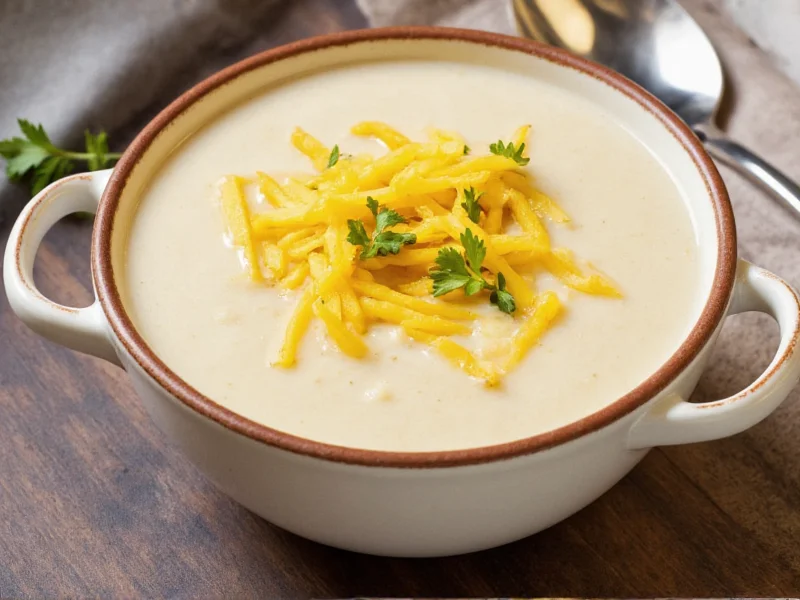Preserving homemade potato soup through freezing offers convenience without sacrificing quality when executed correctly. This comprehensive guide details science-backed methods for freezing, storing, and reheating potato-based soups while maintaining their creamy texture and robust flavor profile. Whether you've prepared a large batch for meal prep or want to extend the shelf life of your favorite recipe, these techniques ensure restaurant-quality results every time.
The Science Behind Freezing Potato Soup
Potato soup presents unique freezing challenges due to its starchy base and common dairy ingredients. When water molecules in the soup freeze, they form ice crystals that can rupture potato cell walls, leading to a grainy texture upon reheating. Dairy components like cream or milk may separate when frozen and thawed improperly. Understanding these chemical processes helps implement effective preservation strategies.
Optimal Freezing Techniques for Potato Soup
Successful freezing begins before the soup ever touches the freezer. Allow freshly prepared soup to cool to room temperature within two hours of cooking to prevent bacterial growth. Never place hot soup directly in the freezer, as this raises the temperature of surrounding items and creates large ice crystals that damage texture.
| Freezing Method | Container Type | Portion Size | Best For |
|---|---|---|---|
| Traditional Freezing | Airtight plastic or glass containers | 1-2 servings | Long-term storage (4-6 months) |
| Flat Freezing | Freezer bags laid flat | Single servings | Quick thawing and space efficiency |
| Ice Cube Tray Method | Silicone trays then transfer to bags | Small portions (1/4 cup) | Adding to recipes or adjusting soup consistency |
Avoiding Common Freezing Mistakes
Many home cooks make critical errors that compromise frozen potato soup quality. Adding dairy at the freezing stage almost guarantees separation upon reheating. Instead, freeze the soup base without cream or milk, then add dairy when reheating. Similarly, overfilling containers causes spills and inconsistent freezing. Leave 1 inch of headspace in rigid containers and press air out of freezer bags to prevent freezer burn.
Herbs like parsley or cilantro lose vibrancy when frozen. For best results, freeze the soup base without delicate herbs, then stir in fresh herbs during reheating. Root vegetables like carrots maintain texture better than potatoes when frozen, so consider slightly undercooking potatoes if you plan to freeze the entire soup.
Thawing Methods That Preserve Quality
The refrigerator thawing method consistently delivers superior results compared to quick-thaw techniques. Transfer frozen soup to the refrigerator 24-48 hours before planned use, depending on portion size. This gradual temperature change minimizes texture degradation and prevents bacterial growth.
When pressed for time, the cold water method provides a safer alternative to microwave thawing. Submerge the sealed container in cold water, changing the water every 30 minutes until thawed. Never thaw frozen soup at room temperature, as this creates a breeding ground for pathogens in the temperature danger zone (40°F-140°F).
Perfect Reheating Procedures
Reheating requires careful temperature management to restore the soup's original consistency. On the stovetop, warm frozen soup over medium-low heat, stirring frequently to prevent scorching. For thawed soup, medium heat suffices. Never boil potato soup vigorously, as this breaks down starch molecules and creates a gluey texture.
If separation occurs during reheating, create a slurry of 1 tablespoon cornstarch mixed with 2 tablespoons cold water. Whisk this into the warming soup to restore creaminess. For dairy-based soups, temper cold cream by gradually adding small amounts of hot soup before incorporating it fully.
Storage Duration Guidelines
While frozen foods remain safe indefinitely at 0°F, quality degrades over time. Potato soup maintains peak quality for:
- 4-6 months: Standard freezer temperature (-0°F to 0°F)
- 2-3 months: Freezer with frequent temperature fluctuations
- 1-2 months: Soups containing dairy or delicate ingredients
Label containers with both preparation and freezing dates. When in doubt about frozen soup quality, check for ice crystals throughout the container (indicating temperature fluctuations) or an off odor upon thawing.
Troubleshooting Common Issues
Grainy texture: This occurs when ice crystals damage potato cell structure. Prevent by cooling soup rapidly before freezing and using waxy potatoes (Yukon Gold) which freeze better than starchy varieties (Russet).
Watery consistency: Thawed soup may separate as water molecules expand during freezing. Fix by simmering gently to re-emulsify ingredients or adding a small amount of instant potato flakes as a thickener.
Off flavors: Freezer burn creates stale, cardboard-like tastes. Prevent by eliminating air exposure through proper packaging. If present, skim affected portions or add fresh aromatics like bay leaves during reheating.











 浙公网安备
33010002000092号
浙公网安备
33010002000092号 浙B2-20120091-4
浙B2-20120091-4